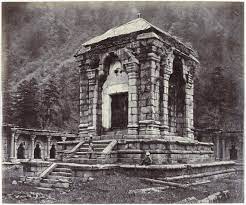Behind Kabali Raid in Kashmir
- Soldier Stories Of Kashmir

- Jun 7, 2021
- 6 min read
Roopesh Mehta
A True Story of Gushi village in Kupwara district, amidst the most unfateful barbaric chaos in Kashmir valley often abridged as 'Exodus of Kashmiri Pandits' that shall go in history of mankind in black.
Kashmiri Pandits began to leave in much greater numbers in the 1990s during the eruption of militancy, following persecution and threats by radical Islamists and militants. The events of 19 January 1990 were particularly vicious. On that day, mosques issued declarations that the Kashmiri Pandits were Kafirs and that the males had to leave Kashmir, convert to Islam or be killed. Those who chose to the first of these were told to leave their women behind. The Kashmiri Muslims were instructed to identify Pandit homes so they could be systematically targeted for conversion or killing.
Having lived it, the author recalls the unfateful days with grief and irrevocable love for his motherland. Who came to rescue ?
yes, the soldiers of Kashmir...

Gushi Gund Village
A village 3 kms in the west of Kupwara. Historians beleive that it might have been established by Kashi Shi who was son of Raja Lov (the settler of Lolab). Kashi Shi had close relations with this area. Some Pandits of Gushi were known as Akhoons. They were academic people. The famous river called KAHMIL flow left side of Sharda temple village. It has its origin in Satkholnag of Kajinag Mountain. It is an important source of irrigation from Chowkibal to Kupwara and then joins Pohru nala near Kupwara and KISHANGANGA river is respected by Hindus and mainly forms the line of control in Keran and Karnah sector of Kupwara. It comes from the Himalayas and joins a river near Dumail Pakistan. The village Gund Gushi, tehsil Uttar Machipora of the erstwhile district Muzafarrabad and presently a part of the district Kupwara, far away from the bustling life of city, is a distant corner of Kashmir. It is a village of indescribable tranquility and serene atmosphere with its hill sides rich in nature's bounty, which invite inquisitiveness and curiosity. The village was home to about thirty five Kashmiri Pandit families comprising nearly two hundred fifty members prior to their forced migration in 1990.
Bhat parivar, claimed an ancient lineage besides being a direct descendant of the indigenous clan of Gund Gushi. Away from the urban hypocrisy and with rural simplicity, he traces his genealogical descent about five hundred years back they were further joined by various kashmiri pandit families including the most prominent cast were Pandita, Akhoon and Dhar.
Mata Sharda
The village which includes Rangwar Gushi has a myriad of legends, beliefs, tales and hearsay stories which form a part of its oral history. A sense of intense religiosity pervades the village's atmosphere due to the presence of Goddess Sharda temple there. The land of Gushi Rangwar is sanctified and hallowed by 'Peer Pandit Padshah Hardu Jahan Mushkil Asan', Reshi Peer, the renowned and celebrated saint of Kashmir, who is said to have spent his childhood days here.
Before and After Picture of Sharadha Tirtha
The ancient temple of Sharada is located in Neelam (Kishanganga) valley just beyond the line of control in Pakistan occupied Kashmir. The temple is located in a small village called Shardi near the confluence of Kishanganga and Madhumati rivers.
History told us that , the renowned Kashmiri Saint Resh Peer belonged to this dynasty. As per his claim, Resh Peer had his maternal grand parents' house (matamal) situated at Gushi Rangwar. The village Gund Gushi is also credited to have three huge Chinar trees, which are reverently known as 'Resh Peer in Booni'. They are believed to have been planted by Resh Peer himself. Resh Peer is said to have planted one of these from the apex. A cherished Temple of Mata Sharda is situated at Rangwar Gushi, having a holy spring within its premises, which is called as Sharda spring. As learned by our four fathers and saints how visited and stayed in the complex of Mata Sharda known as Rangwar. All the spiritual disputes are settled and orders are issued from this hole complex of Sharda Mata.
The Goddess Mata Sharda is believed to have visited this temple from the famous Sharda Peeth Shrine located at the village Dhrov, presently in Pakistan occupied Kashmir. It is also said that the Goddess Sharda has set 'Her' holy feet on one of the hillocks of the village Rangwar Gushi before her permanent depart the Sharda Peeth Shrine. The Goddess Sharda’s resolve to stay permanently there is said to have been revealed in a dream of a devotee at Rangwar Gushi. In the said dream, the Goddess is said to have ordered that one Kashmiri Pandit family of Rangwar Gushi especially of Teez Bhats' clan should come to Sharda Peeth Shrine to serve her there. To obey the order and command of the Goddess mata Sharda, one of the ancestors of bhat family moved there permanently to serve the Goddess at the Sharda Peeth Shrine. Later Pt. Nand Lal Bhat nicknamed as 'Shardi' was appointed a 'pujari' at the famous shrine of Sharda Peeth till his death in 1946.
It was a two day journey from Rangwar Gushi to the Shrine by foot. Right upto the year 1947, the yearly pilgrimage to Sharda Peeth used to commence from Rangwar Gushi and the 'Yatra' included about 500-600 sadhus and devotees. Gund Gushi has also a shrine dedicated to the presiding 'Bhairav' locally known as Mangal Raza, who is also the Bhairav of Karihama and Gotengo, the close by villages. In close proximity to it is the cremation ground, which has a huge Chinar tree, known as 'Raza Boin' and its presiding deity revered as 'Raza Padshah'. People of that village and adjoining areas used to give the offering through sacrificial process called 'Raza Kath' used to be performed at the Bhairav temple and also at Badarkali on Bhadoon Shakul Paksh Navami, the day following Ganga Ashtami every year to propiate the Goddess Kali.
After an elaborate ceremonial pooja, a male ram is be slaughtered and all its body parts cooked using only water and salt with no oil and spices. The cooked preparation is then distributed among the devotees as 'Prasad'. It is mandatory to eat it at the pooja site itself and it is prohibited to take it inside the home. In addition to the usual festivals and rituals, Kashmiri Pandits of Gund Gushi (Kupwara) used to celebrate a lesser known festival of 'Chari Ok Doh' every year on 'Ashad Krishan Paksh'. The ritual involved a symbolic pooja of pestle (Kajawat) placed on a circular grass base (Aari) and the cooking of'dal' rice.
Indian Army Chase Kabalis
The gruesome events and frightful memories associated with Pakistan sponsored tribal invasion (Kabali raid) in the year 1947 still haunts the families of kashmiri pundits. Many innocent pople lost their lives in the tribal attack. Many residents of Gund Gushi, Kupwara were forced to convert to Islam but it was due to the blessing of Mata Sharda (deity of Kashmiri Pandits) that their will power was so strong that they resisted. The opposite forces were destroyed by Indian Army, after hearing the news of killing nine Kashmiri pandits in a line by one bullet.
By that time, the Indian Army had started pouring into Kashmir. From Kulangam, Kashmiri Pandits were taken to Sopore by the Indian Army in their vehicles.
At Sopore, Kashmiri Pandits of Gushi took shelter at the 'sarai' of Haji Samad Pandit and 'Dharampur Sarai' of Pt. Gopi Nath Matu. There they were joined by Kashmiri Pandits belonging to the villages of Sogam, Lalpora, Pazipora, Chandigam, Tekpore, Sholoora, Goetung, Karihama, Moghalpora, Hakachar Nagrimalpora, Drugmulla and Kandikhas villages of the district Kupwara, who too had been forced to move out of their homes and villages due to tribal invasion. The total number of Kashmiri Pandits, who had taken shelter at Sopore was about six thousand. A few among them had moved-out to Srinagar. Later, after three months when the tribal raiders were thrown-out by the Indian Army and the situation normalised, the Kashmiri Pandits of district Kupwara returned back to their villages and homes from their temporary stay at Sopore.
Kabali Barbarous Raid
The tribal raiders again sneaked into Gushi Rangwar. On the very first day, the raiders killed Pt. Ishwar Bhat, in the vicinity of his home, when he was feeding hay to his cattle. After committing this inhuman and savage act, the raiders continued the killing spree. Next, they mercilessly showered a hail of bullets on the inmates of Malla family of Rangwar Gushi, killing nine members of the said family on the spot. The unfortunate souls included Pt. Mahdav Ram Malla, Ramchand, Kanth Malla, Lassa Malla, Jia Lal Malla Shridhar Malla, Prem Nath Malla, Govind Malla and Madhusudhan Malla. These helpless Pandits were subjected to most agonizing torture before being massacred. Subsequently Pt. Veshin Pandit of Trehgam, who had come to Gushi to meet his relatives, also met the same fate. After committing this heinous crime, the leader of the raiders is said to have ordered the forceful conversion of the surviving Pandits of Gushi to Islam.
The conversion ritual involved the snapping of the sacred thread (worn by them and recitation of the Kalima. Caught in between the catastrophic situation and dogged by terror, persecution and terrorization, people were left with no alternative but to leave their village Gushi, with few mighty Chinar and walnut trees, believed to have been planted by Kashmiri Pandits hundreds of years back.

















Comments